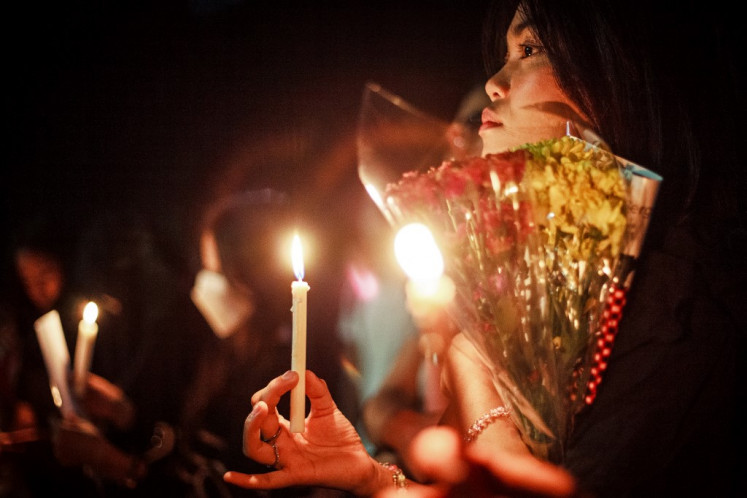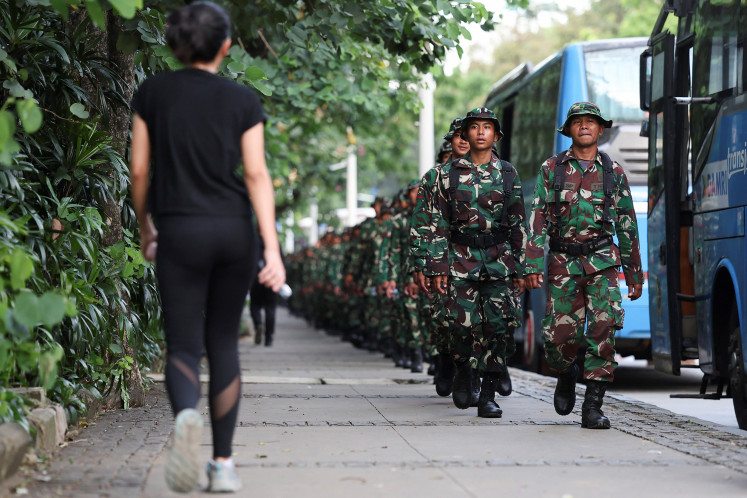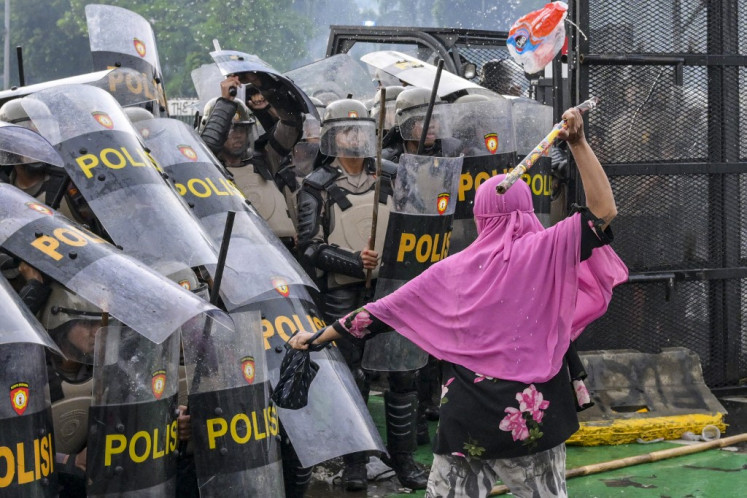Popular Reads
Top Results
Can't find what you're looking for?
View all search resultsPopular Reads
Top Results
Can't find what you're looking for?
View all search resultsStory behind a bowl of frothy green tea
Green matter: Powdered matcha for the chanoyu tea ceremony should be scooped in such a way that makes it look like a hill
Change text size
Gift Premium Articles
to Anyone
G
span class="caption">Green matter: Powdered matcha for the chanoyu tea ceremony should be scooped in such a way that makes it look like a hill.(Arif Suryobuwono)
Just as the well-known kiwi fruit and bonsai originate from China, so too does the globally renowned tea Japanese ceremony, chanoyu, which literally means hot water for tea and philosophically, the way of tea.
Like bread and wine that Christians use as a medium in the Holy Communion to commune with God, tea ' in this case powdered green tea called matcha ' serves as a medium in the elaborately staged ritual to show respect to, and commune harmoniously with, virtually everything in one's surroundings where the ceremony takes place.
Although chanoyu is secular, it has religious elements, growing from the custom of Zen Buddhist monks drinking tea from a single bowl in front of a statue of their founder, Bodhidharma, during their act of worship.
According to several references, this meticulously choreographed tea ritual appears to be modeled after a Chan (known as Zen in Japanese) Buddhism ritual of Song Dynasty China (960-1279), whose rules of etiquette were laid down in detail in 1103 in Chanyuan Qinggui (Rules of Purity for the Chan Monastery), which specifies the ritual required for tea.
Bordering on perfectionism, the monastic code's intricacy and complexity satisfy those with passion for fine detail who strive to hold themselves to very high standards, which today's chanoyu practitioners could easily relate to.
In line with the art of powdered tea prevalent during its gestation period, chanoyu follows the practice of using powdered tea from steam-prepared dried tea leaves and the whipping of the tea powder and hot water together in a bowl that was common in the Song Dynasty.
However, all the complexities and aesthetics of the Chinese tea ceremony on which chanoyu was embryonically based were brought to an abrupt end after a Yuan Dynasty (1279-1368) fleet under the leadership of Kubilai Khan destroyed the last bastion of the Song Dynasty at the Battle of Yamen in 1279, which saw Song chancellor Lu Xiufu drown himself with the emperor.
The Mongol rulers erased aspects of Song culture they disliked including the frothy whipped tea as they favored the strong, dark brick tea mixed with fermented milk they were accustomed to.
Although they tolerated the loose leaf tea newly discovered by their Chinese subjects, tea drinking in China has since been reduced to a mere functional act.
The Chinese later developed another tea ceremony called gongfu cha involving successive brewing of loose-leaf tea poured into small ceramic cups to be shared and appreciated.
'Chanoyu and gongfu cha are two different worlds; each is difficult in its own way,' said Suwarni Widjaja, initially a Chinese tea expert who later branched off into Japanese tea culture.
Prior to the Mongol invasion, however, a Japanese monk named Eisai twice visited Song Dynasty China to learn that Chan Buddhism took Chinese tea seeds to Japan along with the Chinese ideas and customs associated with tea under the Chan Buddhism prevailing at that time, which formed the basis of chanoyu.
Subsequent Japanese pilgrims, scholars and tea masters later on built on Eisai's heritage and developed chanoyu into its present form. So, chanoyu is basically a relic of Song tea culture that was adopted and flourished in Japan, where it found a new spiritual home after its Holy Grail in China completely disappeared.
In Confucianism-influenced Japan, where the subservience of women to men was regarded as natural and proper, chanoyu was initially confined to Zen monasteries, among warriors, the upper class, the ruling class (during the 14th through 16th centuries) and the elites, and was thus almost entirely a male pursuit.
It flourished greatly during the Tokugawa (shogunate) period (1603-1868) during which three chanoyu schools (Urasenke, Omotesenke and Mushanokojisenke) were established.
However, in the following Meiji period (1868-1912), chanoyu fell on hard times as its patrons, territorial warrior rulers, were dissolved as a class. But then, in about two decades, chanoyu began to recover.
Urasenke added chanoyu to the instructional curricula of public schools, especially women's schools, as an essential means for training young ladies in proper etiquette, bearing and aesthetic taste.
This started the feminization of chanoyu, which has since been seen as mainly an activity of women. Yet, at its pinnacle, its original patriarchal nature remains intact. 'Only men can become chanoyu masters. The highest chanoyu rank a woman can achieve is instructor or teacher,' said Suwarni.
Despite this glass ceiling, many women continue to learn the art from Suwarni, including a Muslim woman who wears a kimono with a hijab in the tatami room ' a sign of the times that may help to give this ancient ceremony a contemporary flavor.










